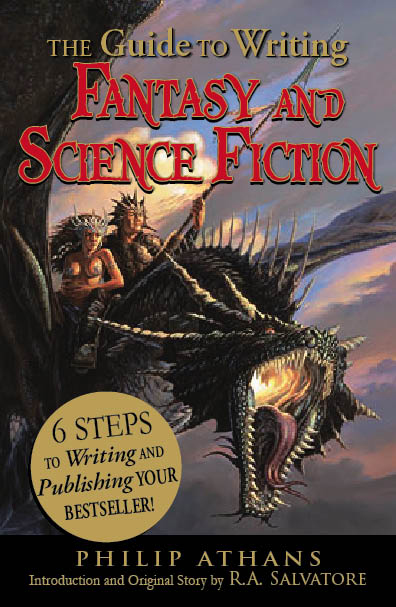As with my previous video on fantasy sub-genres, I’d like to add some additional thoughts and context to the more recent video “The Science:Fiction Ratio for Authors,” which you can watch now, if you haven’t already:
Are there SF sub-genres at all? If you take the bigger view of genres referring to themselves, so sub-genres do the same thing, maybe. But then so do trends, no? In the previous post following up on my take on fantasy sub-genres I dive into the distinction between sub-genres and trends and/or marketing tags. The same could be said of many of the SF “sub-genres” we’ll find out there. But first let’s start with my basic definition of science fiction as a whole, and that’s that science fiction is any story in which the impossible is made possible by some imagined science or technology.
And in the video I muse a bit about the possibility of separating science fiction into epic SF, high SF, and space opera, as I did with fantasy, asking: Can it be made about character motivation? Obviously, motivation is just as vital in SF as it is in any genre, but the science part of science fiction intrudes in ways the magic component in fantasy doesn’t (necessarily). That’s what’s brought me to looking at the SF genre as a ratio of science to fiction. So then, the more a story depends on the workings of the imagined science and technology the more it moves into what we call “hard SF.” And then the less a story depends on the working of the imagined science and technology takes it into “soft SF.” I hate that term, but can we still call it New Wave SF, which is now around sixty years old so doesn’t quite feel as “new”?
I do think it’s worth looking at the genre/sub-genre question in terms of intent. John W. Campbell intended to create “hard SF,” and went out to deliberately make that happen. And by collecting stories by authors working outside the Astounding/Analog camp, or trying to get out of that camp, Harlan Ellison and Michael Moorcock intended to highlight what then became known as the “New Wave.”
Following New Wave were other popular sub-genres. A lot of cyberpunk, for instance, was written by authors who were intentionally jumping on that bandwagon—and I don’t mean that to be as dismissive as I know it sounds, since a lot of those books were terrific. Maybe let’s say those authors were inspired to work in that playground for other than marketing reasons. In any case, the same can be said for steampunk, which came some years later. So then, just like I put forward in terms of fantasy sub-genres, these are trends, not necessarily sub-genres, especially since both these examples, cyberpunk and steampunk—and military SF, too, which I mentioned in the video—have largely fizzled out, but the best of those books, like Neuromancer, Boneshaker, and The Forever War, have lived beyond those moments.
And then looking at science fiction as a ratio, where does a level of extreme science and technology then actually start draining into the fiction side of the scales? Essa Hansen’s Graven Trilogy definitely does that. The technology is so exotic, it feels lots more “fictional” than it does “scientific.” This book—and it’s not the only one out there that does this—at least blurs or really obliterates the line between hard and soft SF. Which then calls into question is there even a reason to look at those ends of the spectrum? It sure feels like they eventually meet in a circle.
A lot still to think about here, but this is Fantasy Author’s Handbook and advice needs be given, so how does all this affect what we, as SF authors, are actually writing right now? What hope do we have that it’ll then be published?
In the video I said it’s hard to sell truly “hard” SF in the current climate but with further thought I’m not so sure. I wasn’t taking into account the significant success of Andy Weir’s The Martian. And Bewilderment does fit into that category as well. If hard SF like The Martian and Bewilderment have been embraced the way they were either popularly or critically, while at the same time “softer” SF, books like Sea of Tranquility or Klara and the Sun that call back much more to “new wave” SF are just as popular and well received. I don’t think there’s any way to see the SF publishing world right now as anything but wide open.
If you’re writing a science fiction novel, just make it a good one, hard, soft, or anywhere in between!
—Philip Athans
Did this post make you want to Buy Me A Coffee…
Follow me on Twitter @PhilAthans…
Link up with me on LinkedIn…
Join our group on GoodReads…
Find me at PublishersMarketplace…
Check out my eBay store…
Or contact me for editing, coaching, ghostwriting, and more at Athans & Associates Creative Consulting?
And Fantasy Author’s Handbook is now on YouTube!
As an Amazon Associate I earn from qualifying purchases.
Absolutely not one word of this post was in any way generated by any version of an “AI” or Large Language Model.
Science fiction and fantasy is one of the most challenging—and rewarding!—genres in the bookstore. But with best selling author and editor Philip Athans at your side, you’ll create worlds that draw your readers in—and keep them reading—with




Science fiction, a tapestry woven with the threads of innovation and storytelling. It transcends the ordinary, igniting our minds with curiosity. Here’s to a genre that paints worlds beyond imagination!